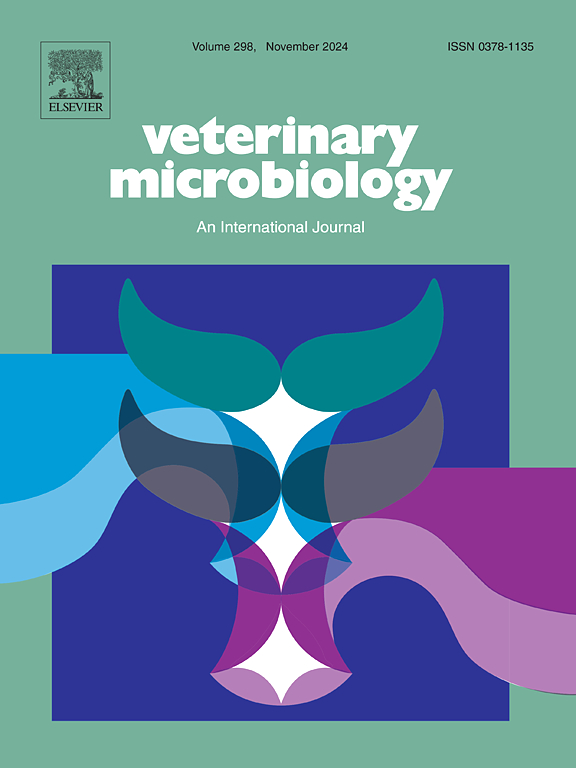Shelter dogs as reservoirs of international clones of Escherichia coli carrying mcr-1.1 and blaCTX-M resistance genes in Lima, Peru
IF 2.4
2区 农林科学
Q3 MICROBIOLOGY
引用次数: 0
Abstract
Antimicrobial resistance (AMR) poses a critical public health threat worldwide, particularly at the human-animal interface where cross-transmission of critical priority Enterobacterales, such as Escherichia coli, have become increasingly reported. Worryingly, E. coli encoding extended-spectrum β-lactamases (ESBLs) has been documented in companion animals worldwide. Conversely, the presence of mcr genes, which confer resistance to polymyxins, in bacteria from pets remains more infrequent. In this study, we sequenced and reported on the first genomic data of E. coli strains carrying mcr-1 and/or blaCTX-M genes isolated from rectal swabs of stray dogs in a shelter in the city of Lima, Peru. Antimicrobial susceptibility revealed that E. coli strains exhibited a multidrug resistance profile. In addition to mcr-1 and blaCTX-M genes, other clinically relevant resistance determinants were identified, with notably presence of blaTEM-176 and the novel blaSCO-2 variant. The association of mcr-1.1 and IncI2 plasmid was confirmed. Several virulence genes were detected, classifying strains as putative extraintestinal pathogenic E. coli. Multilocus sequence typing prediction recognized diverse sequence types (ST), including ST155, ST189, ST657, ST746, ST1140, ST3014, and ST7188. This study represents the first report of mcr-positive E. coli in dogs from Peru, emphasizing the need for continuous surveillance and genomic characterization to better understand the transmission dynamics of these critical resistance genes at the human-animal interface. Furthermore, our results provide evidence that stray, and shelter dogs could be a reservoir for the spread of WHO priority pathogens, and/or polymyxin and β-lactam resistance genes, which is a public health and One Health concern that requires appropriate management strategies.
秘鲁利马收容所的狗是携带mcr-1.1和blaCTX-M耐药基因的大肠杆菌国际克隆的宿主
抗菌素耐药性(AMR)在世界范围内构成严重的公共卫生威胁,特别是在人-动物界面,越来越多地报道了大肠杆菌等重要肠杆菌的交叉传播。令人担忧的是,大肠杆菌编码的广谱β-内酰胺酶(ESBLs)已经在世界各地的伴侣动物中被记录下来。相反,在宠物细菌中,mcr基因的存在(这种基因赋予了对多粘菌素的抗性)仍然比较少见。在这项研究中,我们对携带mcr-1和/或blaCTX-M基因的大肠杆菌菌株进行了测序并报道了首次基因组数据,这些菌株是从秘鲁利马市一个收容所的流浪狗的直肠棉絮中分离出来的。抗菌药物敏感性显示大肠杆菌菌株具有多药耐药特征。除了mcr-1和blaCTX-M基因外,还鉴定了其他临床相关的耐药决定因素,特别是存在bletm -176和新型blaSCO-2变异。证实mcr-1.1与IncI2质粒存在关联。检测到几个毒力基因,将菌株归类为推定的肠外致病性大肠杆菌。多位点序列分型预测识别出多种序列类型(ST),包括ST155、ST189、ST657、ST746、ST1140、ST3014和ST7188。这项研究是秘鲁犬中首次报告的mcr阳性大肠杆菌,强调需要持续监测和基因组鉴定,以更好地了解这些关键耐药基因在人-动物界面的传播动态。此外,我们的研究结果提供了证据,表明流浪狗和收容所狗可能是世卫组织重点病原体和/或多粘菌素和β-内酰胺耐药基因传播的宿主,这是一个公共卫生问题,需要适当的管理策略。
本文章由计算机程序翻译,如有差异,请以英文原文为准。
求助全文
约1分钟内获得全文
求助全文
来源期刊

Veterinary microbiology
农林科学-兽医学
CiteScore
5.90
自引率
6.10%
发文量
221
审稿时长
52 days
期刊介绍:
Veterinary Microbiology is concerned with microbial (bacterial, fungal, viral) diseases of domesticated vertebrate animals (livestock, companion animals, fur-bearing animals, game, poultry, fish) that supply food, other useful products or companionship. In addition, Microbial diseases of wild animals living in captivity, or as members of the feral fauna will also be considered if the infections are of interest because of their interrelation with humans (zoonoses) and/or domestic animals. Studies of antimicrobial resistance are also included, provided that the results represent a substantial advance in knowledge. Authors are strongly encouraged to read - prior to submission - the Editorials (''Scope or cope'' and ''Scope or cope II'') published previously in the journal. The Editors reserve the right to suggest submission to another journal for those papers which they feel would be more appropriate for consideration by that journal.
Original research papers of high quality and novelty on aspects of control, host response, molecular biology, pathogenesis, prevention, and treatment of microbial diseases of animals are published. Papers dealing primarily with immunology, epidemiology, molecular biology and antiviral or microbial agents will only be considered if they demonstrate a clear impact on a disease. Papers focusing solely on diagnostic techniques (such as another PCR protocol or ELISA) will not be published - focus should be on a microorganism and not on a particular technique. Papers only reporting microbial sequences, transcriptomics data, or proteomics data will not be considered unless the results represent a substantial advance in knowledge.
Drug trial papers will be considered if they have general application or significance. Papers on the identification of microorganisms will also be considered, but detailed taxonomic studies do not fall within the scope of the journal. Case reports will not be published, unless they have general application or contain novel aspects. Papers of geographically limited interest, which repeat what had been established elsewhere will not be considered. The readership of the journal is global.
 求助内容:
求助内容: 应助结果提醒方式:
应助结果提醒方式:


